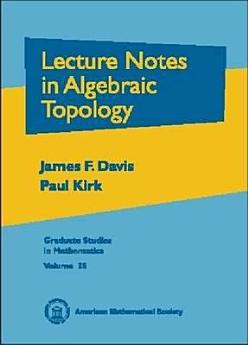Lecture Notes in Algebraic Topology
James Frederic Davis · Paul Kirk
জানু ২০০১ · Crm Proceedings & Lecture Notes কিতাপ 40 · American Mathematical Soc.
ইবুক
367
পৃষ্ঠা
reportমূল্যাংকন আৰু পৰ্যালোচনা সত্যাপন কৰা হোৱা নাই অধিক জানক
এই ইবুকখনৰ বিষয়ে
The amount of algebraic topology a graduate student specializing in topology must learn can be intimidating. Moreover, by their second year of graduate studies, students must make the transition from understanding simple proofs line-by-line to understanding the overall structure of proofs of difficult theorems. To help students make this transition, the material in this book is presented in an increasingly sophisticated manner. It is intended to bridge the gap between algebraic and geometric topology, both by providing the algebraic tools that a geometric topologist needs and by concentrating on those areas of algebraic topology that are geometrically motivated.Prerequisites for using this book include basic set-theoretic topology, the definition of CW-complexes, some knowledge of the fundamental group/covering space theory, and the construction of singular homology. Most of this material is briefly reviewed at the beginning of the book. The topics discussed by the authors include typical material for first- and second-year graduate courses. The core of the exposition consists of chapters on homotopy groups and on spectral sequences. There is also material that would interest students of geometric topology (homology with local coefficients and obstruction theory) and algebraic topology (spectra and generalized homology), as well as preparation for more advanced topics such as algebraic $K$-theory and the s-cobordism theorem.A unique feature of the book is the inclusion, at the end of each chapter, of several projects that require students to present proofs of substantial theorems and to write notes accompanying their explanations. Working on these projects allows students to grapple with the 'big picture', teaches them how to give mathematical lectures, and prepares them for participating in research seminars. The book is designed as a textbook for graduate students studying algebraic and geometric topology and homotopy theory. It will also be useful for students from other fields such as differential geometry, algebraic geometry, and homological algebra. The exposition in the text is clear; special cases are presented over complex general statements.
এই ইবুকখনক মূল্যাংকন কৰক
আমাক আপোনাৰ মতামত জনাওক।
পঢ়াৰ নির্দেশাৱলী
স্মাৰ্টফ’ন আৰু টেবলেট
Android আৰু iPad/iPhoneৰ বাবে Google Play Books এপটো ইনষ্টল কৰক। ই স্বয়ংক্রিয়ভাৱে আপোনাৰ একাউণ্টৰ সৈতে ছিংক হয় আৰু আপুনি য'তে নাথাকক ত'তেই কোনো অডিঅ'বুক অনলাইন বা অফলাইনত শুনিবলৈ সুবিধা দিয়ে।
লেপটপ আৰু কম্পিউটাৰ
আপুনি কম্পিউটাৰৰ ৱেব ব্রাউজাৰ ব্যৱহাৰ কৰি Google Playত কিনা অডিঅ'বুকসমূহ শুনিব পাৰে।
ই-ৰীডাৰ আৰু অন্য ডিভাইচ
Kobo eReadersৰ দৰে ই-চিয়াঁহীৰ ডিভাইচসমূহত পঢ়িবলৈ, আপুনি এটা ফাইল ডাউনল’ড কৰি সেইটো আপোনাৰ ডিভাইচলৈ স্থানান্তৰণ কৰিব লাগিব। সমৰ্থিত ই-ৰিডাৰলৈ ফাইলটো কেনেকৈ স্থানান্তৰ কৰিব জানিবলৈ সহায় কেন্দ্ৰত থকা সবিশেষ নিৰ্দেশাৱলী চাওক।









